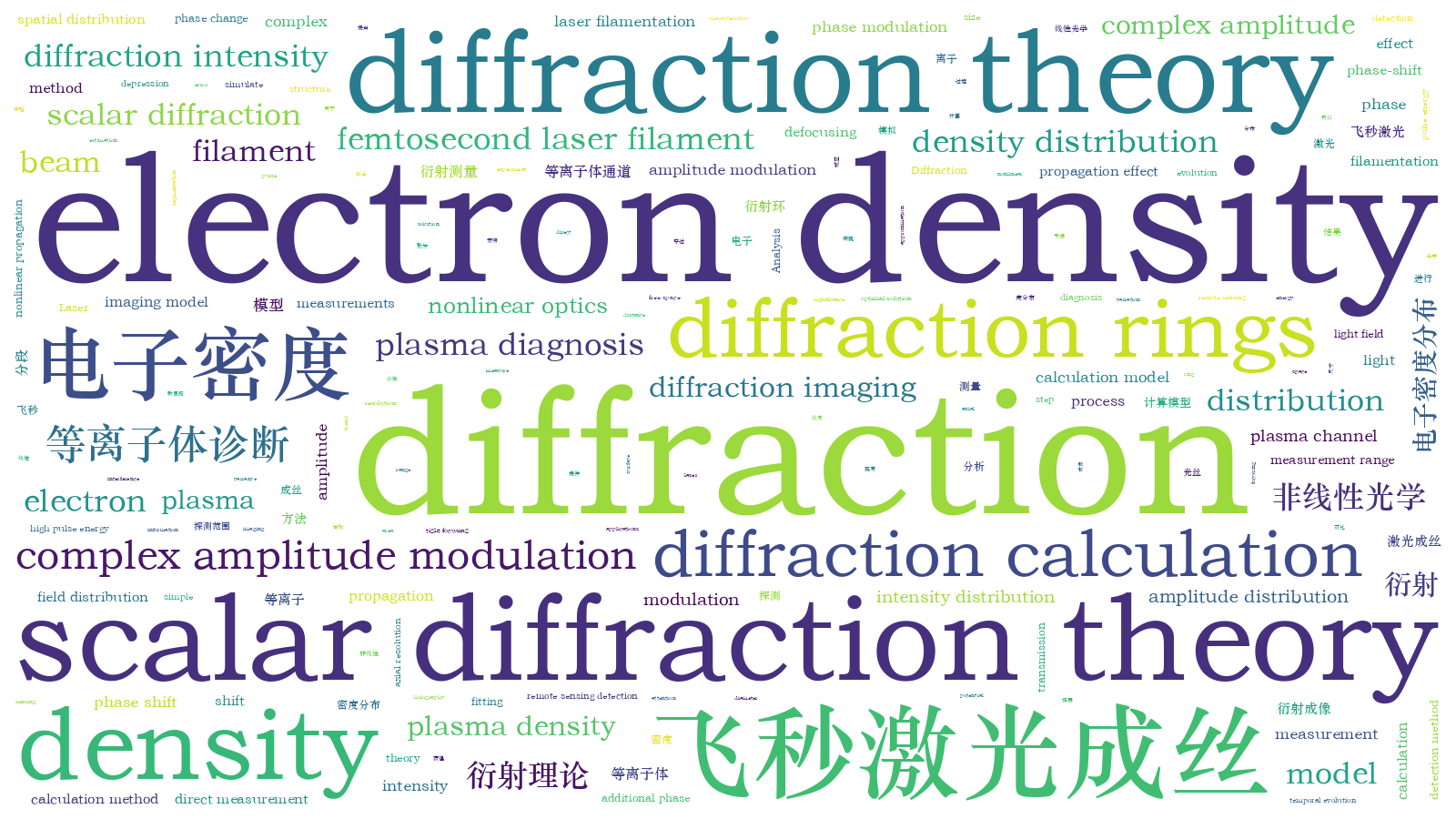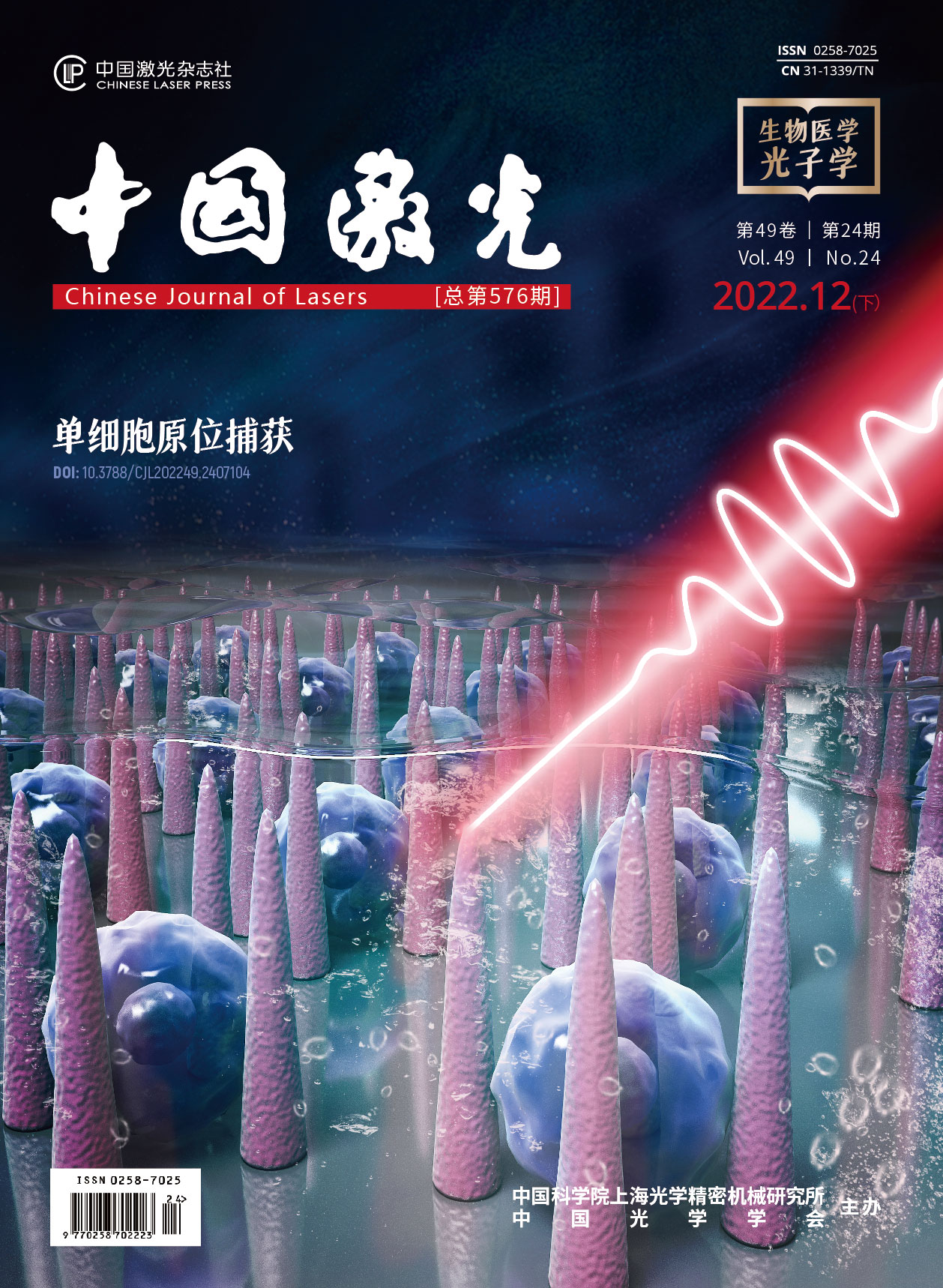飞秒激光成丝的衍射分析方法  下载: 716次
下载: 716次
Femtosecond laser filamentation has garnered significant attention and shown great potential in guiding discharge and remote sensing detection owing to its unique characteristics. The measurement of the size and internal electron density of a filament is of great significance for understanding the nonlinear propagation and evolution law of a filament and for developing various applications. Electron density measurements in a filament can be divided into two categories: direct measurement detection method such as electrical measurement and measurement of the density by interference, diffraction, and holography. The experimental setup of the longitudinal diffraction method is relatively simple, and the temporal evolution of plasma density can be recorded at the expense of axial resolution information. However, the diffraction propagation models of probe beam based on the longitudinal diffraction method in previous studies ignored the modulation of the probe beam intensity affected by plasma defocusing. Modulation from the plasma defocusing effect cannot be ignored when the plasma density is high. In this study, a segmented diffraction imaging model based on scalar diffraction theory is established to accurately simulate the diffraction transmission process of a probe beam.
Scalar diffraction theory effectively describes the propagation of light in free space and is a reasonable approximation of the propagation effect of light. In this work, a plasma channel was divided equally into N segments; the length of each segment was Δd=Lfil/N, and the complex amplitude distribution of the probe beam at the entrance of the filament (z=z0) was U0=exp(-ar2). The defocusing modulation experienced by the probe beam in each section was regarded only as a phase change. The calculation process is illustrated in Figure 2. First, the diffraction transmission result of the probe beam at a distance was calculated using equation (1). Second, the result of the first step was multiplied by the phase shift caused by this section of the filament. The result of the second step was the final light-field distribution in this section and the complex amplitude distribution of the initial plane of the next transmission process. Finally, the first and second steps were repeated N times, and the complex amplitude distribution at the exit of the filament was obtained. A comparison was made between the segmented diffraction model and previous models.
The structure of the diffraction ring changes correspondingly with changes in ne0 and w. The intensity of higher-order diffraction rings and the number of diffraction rings increase with an increase in the electron density. The modulation of the central region is enhanced, and the intensity of the high-order diffraction rings is weakened with an increase in the filament radius. Additionally, the radius of the diffraction rings always increases with an increase in ne0 and w. Under the conditions of high pulse energy and tight focusing, the early high-density plasma channel shows strong diffraction modulation for the probe beam [Figure 4(a1)]. The SSE logarithmic surfaces with N=25 and N=10 produce a significant depression area, and the minimum values in the depression are obtained at (ne0, 2w)=(8.8×1017 cm-3, 90 μm) using the segmented diffraction model. The corresponding fitting results are shown in Figure 4 (e1). The plasma defocusing effect is only reflected in the additional phase shift, and the optimal solution corresponding to the minimum value of the SSE is (ne0, 2w)=(2.1×1018 cm-3, 90 μm) with the number of segments N=0. The SSE value of segment N=0 is larger than that based on the segment diffraction model. This indicates that the corresponding fitting effect of segments N=0 is worse than that of the segmented model. The surface obtained without segmentation does not produce a prominent concave region; therefore, the minimum value is insignificant and the corresponding electron density distribution is not accurate and reliable. The probe beam is only subject to a change in the phase shift, and the diffraction intensity distribution deviates greatly from the actual situation. It is difficult to accurately measure the electron density and diameter of a filament with a relatively high electron density. The SSE value of segments N=0 is also larger than the result based on the segment diffraction model under the relatively low electron density condition [Figure 4(e2)]. The measurement results of the two models are similar, and both fit the experimental results well when the electron density drops to approximately 1×1017 cm-3. The plasma channel is assumed to have a cylindrical symmetric electron density distribution. The modulation effect of the probe beam passing through the plasma channel is not a simple phase modulation but a complex amplitude modulation. The consideration of directly adding a phase-shift model to this modulation process is imperfect. The segmented diffraction calculation reflects the process by which the complex amplitude of the light field is modulated as a whole. The segmented calculation simulates the distribution of the complex amplitude of the modulated probe beam with a smaller fitting error. Correspondingly, the radial spatial distribution of the electron density of the filament can be obtained more accurately. The radial intensity distribution of the experimental curve is relatively stable. The radial intensity variation trend of the diffraction structure fitted according to the minimum value of the sum variance SSE is consistent with the experimental results. The calculation method based on subsection diffraction is reasonable and reliable for the diagnosis and estimation of electron density distribution.
A piecewise diffraction calculation model based on scalar diffraction theory was proposed to simulate the propagation of probe beam in the same direction as the filament. Based on this model, the diffraction rings of the detected light recorded in the experiment were fitted. The results show that the segmented diffraction model can extend the measurement range for higher electron densities. The measurements of the electron density and filament size based on the segmented diffraction model provide a new analysis method for the precise diagnosis of filaments.
1 引言
强飞秒激光在空气等透明介质中传播时,若光克尔自聚焦效应与中性分子电离产生的等离子体散焦效应之间达到了动态平衡,飞秒激光就会在介质中形成等离子体通道,即成丝现象[1-4]。飞秒激光成丝在引导控制放电[5-7]、遥感探测[8-10]、太赫兹辐射[11-14]和超短脉冲压缩[15-16]等领域显示出了极大的应用潜力。光丝尺寸及其内部电子密度的测量对于理解光丝的传输和演化规律、开展各项应用都具有重要意义。一般来说,光丝内电子密度的测量通常可以分为两大类。其中的一类探测方法,如电学测量法[17]、声学测量法[18]和荧光测量法[19]等,相对来说要简单易行一些,但是若要获得电子密度的绝对值则需要定标,并且精度有限,不具有时间分辨的能力;另一类方法,如利用干涉[20-22]、衍射[23-26]和全息[27-29]实现密度测量的方法,在实验设置上都具有泵浦探测的实验结构,这类方法通过等离子体所引起的探测光的相位改变量提取出电子密度,同时可以通过调节泵浦光和探测光的时间延时获得电子密度的时空演化信息。利用干涉原理相对来说能获得更精确的电子密度分布,尤其是沿光丝轴向的密度分布,但为了获得干涉条纹,需要将探测光分成两束并进行准确调节使其时空同步,从而增加了实验操作的复杂性。纵向衍射法的实验光路相对来说更简单,可以在牺牲轴向分辨信息的情况下观测到等离子体密度随时间的演化。
在已有的基于纵向衍射法的工作中[19, 24, 26],研究人员所使用的探测光衍射传播模型有一定的局限性,即:当电子密度并不是非常高(<1017 cm-3)或者等离子体通道不是很长时,通道内的电子导致的探测光的偏折可以忽略。因此,他们假设探测光沿轴向穿过光丝后,等离子体的散焦效应只改变了探测光复振幅的相位项,即只引起了一个与电子密度有关的额外的常数相移。但实际上,探测光的光强分布会受到等离子体散焦效应的调制,尤其是当等离子体密度较高时,这种调制更是不可忽略的,否则会影响提取到的电子密度和光丝直径的准确性。本课题组根据标量衍射理论建立了分段衍射成像模型,以精确模拟探测光的衍射传输过程,并以该模型为基础对实验记录的衍射图像进行拟合,提取出了电子密度和光丝尺寸信息。该模型不仅适用于模拟较低电子密度下的衍射情况,同时也适用于电子密度较高时需要考虑光丝散焦效应的情况。
2 基本理论
纵向衍射法的光路模型如

图 1. 探测光被光丝衍射后成像的计算模型图
Fig. 1. Computational model diagram of probe beam diffracted by filament
标量衍射理论可以有效描述自由空间中光的传输过程,它是对光的传输效应的一个合理近似[30-31]。菲涅耳衍射积分[30-32]通常是模拟衍射过程的首选方法,因为它适用的传输场景比较广泛,且在计算上相对简单直观。它可以表示为
在当前现有的研究[19,24,26]中,研究人员假设探测光的初始复振幅分布为Uin=exp(-ar2),经等离子体通道调制后,通道出口处的复振幅分布为Uout=exp(-ar2)exp[jφ(r) ],其中φ(r)=-k[ne/2nc]Lfil是整段光丝引起的总相移,a是探测光束腰半径平方的倒数,然后根据标量衍射理论计算得到像面上的光强分布。他们在计算过程中认为探测光在等离子体通道入口和出口处的光强分布是相同的,同时假设低密度等离子体的散焦效应只体现在相位改变上。当电子密度较高且径向梯度变化较大时,该假设会使电子密度的精确测量变得困难[24]。为了获得相对更准确的衍射结果,使纵向衍射法在较高电子密度下仍能实现较精确的测量,本课题组利用下面的计算过程模拟探测光在等离子体通道中的散焦效应。如

图 2. 探测光在等离子体通道中传输时的计算流程图
Fig. 2. Computation flow chart when probe beam propagates in plasma channel

图 3. 探测光强度分布的模拟结果。不同分段数下探测光的径向强度分布:(a)光丝出口处;(b)CCD成像端。分段数为25时的平面光强分布:(c)光丝出口处;(d)CCD成像端
Fig. 3. Simulation results of intensity distribution of probe beam. Radial intensity distribution of probe beam at different numbers of segments: (a) at the exit of filament; (b) at CCD imaging end. Plane intensity distribution when the number of segments is 25: (c) at the exit of filament; (d) at CCD imaging end
3 拟合与分析
将模拟结果与实验值进行拟合,可以提取出电子密度分布和光丝尺寸的信息。实验中成丝所用的泵浦激光的中心波长为800 nm,脉宽为30 fs,脉冲重复频率为50 Hz。泵浦激光经焦距为30 cm的正透镜聚焦成丝,成丝前泵浦光脉冲能量为4.5 mJ,根据荧光测得光丝的长度约为1 cm。波长为400 nm的探测光由飞秒激光倍频得到,可以调节其与泵浦光之间的延时。用CCD记录探测光的衍射像。由前述可知,模拟得到的衍射条纹分布受每一段光丝产生的相移的影响,即与式(6)中的ne0和w相关。当改变ne0和w时,衍射环的结构会发生相应的变化。增大峰值电子密度可使较高级次的衍射环强度增大,进而使得衍射环的数目变多;而增大光丝半径会使中心区域受到的调制增强,高级次的衍射环强度减弱,且沿径向衰减得更快。此外,衍射环的半径始终随着ne0和w的增大而增大。为了便于后续的拟合,将计算中光场平面的采样间隔设置成与CCD像元尺寸一致,均为6.45 μm,且预先对模拟和实验得到的强度值均沿着径向取平均并分别进行归一化处理。首先改变初始变量ne0和w,计算得到一系列不同的像面衍射强度分布;然后将每一个模拟结果都与实验结果进行比较,判断拟合的接近程度,提取出对应的ne0和w。当前有关纵向衍射法的研究对于拟合过程的描述比较模糊,而且对于模拟结果是否达到最佳拟合状态的判断具有一定的主观性。本文通过计算二者的误差平方和(SSE)来寻找最合适的拟合状态。则,对于第i个模拟结果有
依照上述拟合过程,分别选取分段数N为25、10和0,对实验记录的衍射圆环进行拟合。

图 4. 不同延时下的模拟和计算结果。(a1)~(a3)CCD记录的不同时刻的衍射环;(b1)~(d3)不同延迟和分段数下SSE计算值的分布图;(e1)~(e3)拟合结果
Fig. 4. Simulated and calculated results at different delays. (a1)-(a3) Diffraction patterns at different delays recorded by CCD;(b1)-(b3) distribution maps of calculated SSE values at different delays and segments; (e1)-(e3) fitting results

图 5. 实验测量误差与拟合误差的比较(延时为37.31 ps)
Fig. 5. Comparison of experimental measurement error and fitting error (delay time is 37.31 ps)
4 结论
本课题组提出了一个基于标量衍射理论的分段衍射计算模型,并将其用于模拟探测光在与光丝同向传播时被等离子体通道衍射调制的过程。基于该模型对实验记录的探测光衍射环进行了拟合,以模拟结果与实验结果之间的SSE为判断标准,获得最合适的拟合结果,进而提取出对应的峰值电子密度和光丝直径。将分段衍射模型与当前研究中使用的直接添加相移的模型进行了对比,结果表明:分段衍射模型不仅适用于较低电子密度分布的测量与提取,同时也适用于电子密度较高、衍射效应较强的情况;直接添加相移的模型在较高电子密度情况下的测量结果偏差较大。分段衍射模型拓展了纵向衍射法的测量范围,为不同电子密度条件下等离子体通道的精确衍射测量提供了新思路。
[1] ChinS L. Filamentation physics[M]∥Springer series on atomic, optical, and plasma physics. New York: Springer, 2009, 55: 11-48.
[2] Bergé L, Skupin S, Nuter R, et al. Ultrashort filaments of light in weakly ionized, optically transparent media[J]. Reports on Progress in Physics, 2007, 70(10): 1633-1713.
[3] Kasparian J, Wolf J P. Physics and applications of atmospheric nonlinear optics and filamentation[J]. Optics Express, 2008, 16(1): 466-493.
[4] 刘伟伟, 薛嘉云, 苏强, 等. 超快激光成丝现象研究综述[J]. 中国激光, 2020, 47(5): 0500003.
[5] Rodriguez M, Sauerbrey R, Wille H, et al. Triggering and guiding megavolt discharges by use of laser-induced ionized filaments[J]. Optics Letters, 2002, 27(9): 772-774.
[6] Clerici M, Hu Y, Lassonde P, et al. Laser-assisted guiding of electric discharges around objects[J]. Science Advances, 2015, 1(5): e1400111.
[7] Wang T J, Wei Y X, Liu Y X, et al. Direct observation of laser guided corona discharges[J]. Scientific Reports, 2016, 5: 18681.
[8] Kasparian J, Rodriguez M, Méjean G, et al. White-light filaments for atmospheric analysis[J]. Science, 2003, 301(5629): 61-64.
[9] Luo Q, Xu H L, Hosseini S A, et al. Remote sensing of pollutants using femtosecond laser pulse fluorescence spectroscopy[J]. Applied Physics B, 2006, 82(1): 105-109.
[10] 王铁军, 陈娜, 郭豪, 等. 飞秒强激光大气遥感新技术的原理和研究进展[J]. 激光与光电子学进展, 2022, 59(7): 0700001.
[11] Xie X, Dai J M, Zhang X C. Coherent control of THz wave generation in ambient air[J]. Physical Review Letters, 2006, 96(7): 075005.
[12] Kim K Y, Taylor A J, Glownia J H, et al. Coherent control of terahertz supercontinuum generation in ultrafast laser–gas interactions[J]. Nature Photonics, 2008, 2(10): 605-609.
[13] Wang T J, Yuan S, Chen Y P, et al. Toward remote high energy terahertz generation[J]. Applied Physics Letters, 2010, 97(11): 111108.
[14] 惠雨晨, 赵佳宇. 外电场作用下飞秒激光成丝辐射太赫兹波的全电流模型[J]. 光学学报, 2022, 42(1): 0114002.
[15] Hauri C P, Kornelis W, Helbing F W, et al. Generation of intense, carrier-envelope phase-locked few-cycle laser pulses through filamentation[J]. Applied Physics B, 2004, 79(6): 673-677.
[16] 冯天利, 商景诚, 李涛. 基于双光成丝过程的光参量啁啾脉冲放大器前端[J]. 中国激光, 2022, 49(7): 0708002.
[17] Abdollahpour D, Suntsov S, Papazoglou D G, et al. Measuring easily electron plasma densities in gases produced by ultrashort lasers and filaments[J]. Optics Express, 2011, 19(18): 16866-16871.
[18] Yu J, Mondelain D, Kasparian J, et al. Sonographic probing of laser filaments in air[J]. Applied Optics, 2003, 42(36): 7117-7120.
[19] Théberge F, Liu W W, Simard P T, et al. Plasma density inside a femtosecond laser filament in air: strong dependence on external focusing[J]. Physical Review E, 2006, 74(3): 036406.
[20] Clark T R, Milchberg H M. Time- and space-resolved density evolution of the plasma waveguide[J]. Physical Review Letters, 1997, 78(12): 2373-2376.
[21] Yang H, Zhang J, Li Y J, et al. Characteristics of self-guided laser plasma channels generated by femtosecond laser pulses in air[J]. Physical Review E, 2002, 66(1): 016406.
[22] Wahlstrand J K, Chen Y H, Cheng Y H, et al. Measurements of the high field optical nonlinearity and electron density in gases: application to filamentation experiments[J]. IEEE Journal of Quantum Electronics, 2012, 48(6): 760-767.
[23] Tzortzakis S, Prade B, Franco M, et al. Time-evolution of the plasma channel at the trail of a self-guided IR femtosecond laser pulse in air[J]. Optics Communications, 2000, 181(1/2/3): 123-127.
[24] Liu J S, Duan Z L, Zeng Z N, et al. Time-resolved investigation of low-density plasma channels produced by a kilohertz femtosecond laser in air[J]. Physical Review E, 2005, 72(2): 026412.
[25] Rodriguez G, Valenzuela A R, Yellampalle B, et al. In-line holographic imaging and electron density extraction of ultrafast ionized air filaments[J]. Journal of the Optical Society of America B, 2008, 25(12): 1988-1997.
[26] Zhang Z, Lu X, Xi T T, et al. Long distance filamentation of 400 nm femtosecond laser pulses in air[J]. Applied Physics B, 2009, 97(1): 207-213.
[27] Centurion M, Pu Y, Liu Z W, et al. Holographic recording of laser-induced plasma[J]. Optics Letters, 2004, 29(7): 772-774.
[28] Abdollahpour D, Papazoglou D G, Tzortzakis S. Four-dimensional visualization of single and multiple laser filaments using in-line holographic microscopy[J]. Physical Review A, 2011, 84(5): 053809.
[29] Petrov N V, Putilin S E, Chipegin A A. Time-resolved image plane off-axis digital holography[J]. Applied Physics Letters, 2017, 110(16): 161107.
[30] GoodmanJ W. Introduction to Fourier optics[M]. 4th ed. San Francisco: McGraw-Hill, 2017.
[31] Voelz, DavidG. Computational Fourier optics: a MATLAB tutorial [M]. Bellingham: SPIE, 2011.
[32] KhareK. Fresnel and Fraunhoffer diffraction[M]∥Fourier optics and computational imaging. Chichester: John Wiley & Sons, Inc., 2015: 153-165.
郑恒毅, 尹富康, 王铁军, 刘尧香, 魏迎霞, 朱斌, 周凯南, 冷雨欣. 飞秒激光成丝的衍射分析方法[J]. 中国激光, 2022, 49(24): 2408001. Hengyi Zheng, Fukang Yin, Tiejun Wang, Yaoxiang Liu, Yingxia Wei, Bin Zhu, Kainan Zhou, Yuxin Leng. Diffraction Analysis of Femtosecond Laser Filaments[J]. Chinese Journal of Lasers, 2022, 49(24): 2408001.






